Numerical Simulation and Experimental Study of Cold and Hot Composite Forming of Sharp-Edged High-Strength Steel Sections
Abstract
:1. Introduction
2. Mathematical Model
2.1. Electromagnetic Field Model
2.2. Temperature Field Model
2.3. Geometric Model
3. Numerical Simulation
3.1. Pre-Processing
3.2. Solving
3.3. Post-Processing
4. Results and Discussion
4.1. Magnetic Core Influence on Field Strength
4.2. Effect of Heating Current and Frequency on Temperature Distribution
4.3. Effect of Frequency on the Magnetic Induction Strength
5. Experimental Validation
Heating Temperature
6. Conclusions
- (1)
- An electromagnetic–thermal field coupling model was established to study sharp-edged steel’s cold and hot composite forming process. The effects of different heating process parameters on the simulation results were analyzed, and experimental research based on optimized parameters was conducted. It was found that the relative errors between the simulated and measured heating temperatures were 5.37% and 5.02%, respectively. The results indicate that the finite element model has excellent predictive capability and can be used to guide actual production and process optimization.
- (2)
- Using magnetic flux field concentrators can significantly enhance the magnetic field intensity of the simulation results. Therefore, installing magnetic flux field concentrators in local induction heating technology can effectively improve the efficiency of local induction heating.
- (3)
- The simulation results indicate that the peak magnetic induction intensity is proportional to the heating frequency. This process’s optimal heating frequency, current, and heating time are 40 kHz, 3000 A, and 2 s, respectively. It can heat the center temperature of the cross section of the sharp-edged steel corner to 850 °C, and the magnetic flux density B reaches 2.51 T.
- (4)
- Based on the experimental results, using the heating process parameters optimized through the numerical simulation, the heating temperature matched the expected values, indicating that cold and hot composite forming technology could be adopted to produce sharp-edged steel profiles for the curtain wall industry. Moreover, the dimensional accuracy of the sharp-edged steel was also high, indicating that it meets the requirements for engineering applications.
- (5)
- The mechanism of the influence of process parameters on the temperature, such as heating current, frequency, and distance between the induction coil and the steel profile, requires further research.
Author Contributions
Funding
Institutional Review Board Statement
Informed Consent Statement
Data Availability Statement
Conflicts of Interest
References
- Fu, L.; Xu, G.; Yan, Y.; Yang, J.; Xie, J. The Application and Research Progress of High Strength and High Performance Steel in Building Structure. IOP Conf. Ser. Mater. Sci. Eng. 2018, 392, 022008. [Google Scholar] [CrossRef]
- Shao, Y.; Zhang, Y.; Hassanein, M.F. Strength and behaviour of laterally-unrestrained S690 high-strength steel hybrid girders with corrugated webs. Thin-Walled Struct. 2020, 150, 106688. [Google Scholar] [CrossRef]
- Lago, J.; Trško, L.; Jambor, M.; Nový, F.; Bokůvka, O.; Mičian, M.; Pastorek, F. Fatigue Life Improvement of the High Strength Steel Welded Joints by Ultrasonic Impact Peening. Metals 2019, 9, 619. [Google Scholar] [CrossRef]
- Wang, A.; Xue, H.; Bayraktar, E.; Yang, Y.; Saud, S.; Chen, P. Analysis and Control of Twist Defects of Aluminum Profiles with Large Z-Section in Roll Bending Process. Metals 2019, 10, 31. [Google Scholar] [CrossRef]
- Su, C.-J.; Yang, L.-Y.; Lou, S.-M.; Wang, Q.; Wang, R. Research on roll forming process based on five-boundary condition forming angle distribution function. Int. J. Adv. Manuf. Technol. 2019, 102, 3767–3779. [Google Scholar] [CrossRef]
- Duggal, N.; Ahmetoglu, M.A.; Kinzel, G.L.; Altan, T. Computer aided simulation of cold roll forming—A computer program for simple section profiles. J. Mater. Process. Technol. 1996, 59, 41–48. [Google Scholar] [CrossRef]
- Saffe, S.N.b.M.; Nagamachi, T.; Ona, H. Mechanism of End Deformation after Cutting of Light Gauge Channel Steel Formed by Roll Forming. Mater. Trans. 2015, 56, 187–192. [Google Scholar] [CrossRef]
- Li, M.; Zhao, Y.X.; Hu, X.; Huang, S. Experimental Study of Shear Fracture on Advanced High Strength Dual-Phase Steels. J. Shanghai Jiao Tong Univ. 2011, 45, 1695–1699. [Google Scholar] [CrossRef]
- Wang, F.; Zhao, O.; Young, B. Testing and numerical modelling of S960 ultra-high strength steel angle and channel section stub columns. Eng. Struct. 2020, 204, 109902. [Google Scholar] [CrossRef]
- Traub, T.; Chen, X.; Groche, P. Experimental and numerical investigation of the bending zone in roll forming. Int. J. Mech. Sci. 2017, 131–132, 956–970. [Google Scholar] [CrossRef]
- Abathun, M.Z.; Han, J.; Yu, W. Effects of manufacturing methods and production routes on residual stresses of rectangular and square hollow steel sections: A review. Arch. Civ. Mech. Eng. 2021, 21, 100. [Google Scholar] [CrossRef]
- Souto, C.D.S.; Menghini, A.; Díaz, A.; Manso, J.M.; de Jesus, A.M.P.; Castiglioni, C.A. Determination of manufacturing residual stresses in cold-formed thin-walled steel profiles. Thin-Walled Struct. 2022, 180, 109945. [Google Scholar] [CrossRef]
- Prosgolitis, C.G.; Kermanidis, A.T.; Kamoutsi, H.; Haidemenopoulos, G.N.; Karamanos, S.A. Influence of plastic prestraining on the fatigue crack propagation rate of S355MC and S460MC structural steels. Fatigue Fract. Eng. Mater. Struct. 2021, 44, 1391–1405. [Google Scholar] [CrossRef]
- Sun, Y.; Luzin, V.; Duan, Y.; Varma, R.; Shi, L.; Weiss, M. Forming-Induced Residual Stress and Material Properties of Roll-Formed High-Strength Steels. Automot. Innov. 2020, 3, 210–220. [Google Scholar] [CrossRef]
- Chen, J.; Liu, H.; Chan, T.-M. Material properties and residual stresses of cold-formed octagonal hollow sections. J. Constr. Steel Res. 2020, 170, 106078. [Google Scholar] [CrossRef]
- Prosgolitis, C.G.; Kermanidis, A.T.; Kamoutsi, H.; Haidemenopoulos, G.N. Low Cycle Fatigue Behavior of Plastically Pre-Strained HSLA S355MC and S460MC Steels. Materials 2022, 15, 7927. [Google Scholar] [CrossRef]
- Liu, J.-Z.; Fang, H.; Chan, T.-M. Investigations on material properties and residual stresses in cold-formed high strength steel irregular hexagonal hollow sections. Thin-Walled Struct. 2022, 176, 109220. [Google Scholar] [CrossRef]
- Wang, Y.; Mehari, Z.A.; Wu, J.; Han, J. Optimization design of process parameters for cold and hot composite roll forming of the AHSS square tube using response surface methodology. Int. J. Adv. Manuf. Technol. 2022, 123, 527–542. [Google Scholar] [CrossRef]
- Pandre, S.; Morchhale, A.; Kotkunde, N.; Singh, S.K. Influence of processing temperature on formability of thin-rolled DP590 steel sheet. Mater. Manuf. Process. 2020, 35, 901–909. [Google Scholar] [CrossRef]
- Ozturk, F.; Ece, R.E.; Polat, N.; Koksal, A. Effect of Warm Temperature on Springback Compensation of Titanium Sheet. Mater. Manuf. Process. 2010, 25, 1021–1024. [Google Scholar] [CrossRef]
- Al-Obaidi, A.; Kräusel, V.; Landgrebe, D. Hot single-point incremental forming assisted by induction heating. Int. J. Adv. Manuf. Technol. 2015, 82, 1163–1171. [Google Scholar] [CrossRef]
- Eyercioglu, O.; Alacaci, S.; Aladag, M. Experimental Investigation of Springback of Locally Heated Advanced-High Strength Steels. Int. J. Res.-Granthaalayah 2021, 9, 269–277. [Google Scholar] [CrossRef]
- Yan, P.J.; Han, J.T.; Jiang, Z.Y.; Li, H.J.; Li, D.Y. Study on Properties of High Strength Steel during Warm Roll Forming. Adv. Mater. Res. 2012, 472–475, 2783–2787. [Google Scholar] [CrossRef]
- Peng, X.-F.; Liu, J.; Han, J.-T.; Wei, D.-B. Effect of hot/warm roll-forming process on microstructural evolution and mechanical properties of local thickened U-rib for orthotropic steel deck. J. Iron Steel Res. Int. 2017, 24, 335–342. [Google Scholar] [CrossRef]
- Engel, B.; Selter, O. Development of a Roll Forming Process with Modular Bending Operations. ATZproduktion Worldw. 2012, 5, 30–36. [Google Scholar] [CrossRef]
- Wang, Y.; Mehari, Z.A.; Wu, J.; Han, J. Effect of induction heating temperature on the microstructure and mechanical properties of HSLA square tubes. Mater. Res. Express 2022, 9, 106504. [Google Scholar] [CrossRef]
- Mehari, Z.A.; Han, J.; Peng, X.; Wang, Y. Analysis of stress-strain in the partial heating roll forming process of high strength square hollow steel sections. Int. J. Adv. Manuf. Technol. 2021, 115, 563–579. [Google Scholar] [CrossRef]
- Mehari, Z.A.; Han, J. Investigations of the through-thickness residual stress distribution during the partial heating roll forming process of square and rectangular hollow steel sections. Eng. Rep. 2022, 4, 15. [Google Scholar] [CrossRef]
- Mehari, Z.A.; Han, J. Effects of the partial heating roll forming method on springback of high strength steel. Int. J. Adv. Manuf. Technol. 2022, 119, 5195–5210. [Google Scholar] [CrossRef]
- Lan, X.; Chan, T.-M.; Young, B. Experimental and numerical studies on stress concentration factors of high strength steel fabricated box X-joints. Thin-Walled Struct. 2021, 164, 107858. [Google Scholar] [CrossRef]
- Jiang, J.; Chiew, S.; Lee, C.; Tiong, P. A numerical study on residual stress of high strength steel box column. J. Constr. Steel Res. 2017, 128, 440–450. [Google Scholar] [CrossRef]
- Radwan, M.; Kövesdi, B. Improved design method for interaction buckling resistance of welded box-section columns. J. Constr. Steel Res. 2022, 194, 107334. [Google Scholar] [CrossRef]
- Zimin, L.S.; Sorokin, A.G.; Egiazaryan, A.S.; Filimonova, O.V. Systematic approach to optimal design of induction heating installations for aluminum extrusion process. IOP Conf. Ser. Mater. Sci. Eng. 2018, 327, 022112. [Google Scholar] [CrossRef]
- Mei, R.; Li, C.; Liu, X.; Li, B.; Han, B. Modeling of Slab Induction Heating in Hot Rolling by FEM. Engineering 2011, 3, 364–370. [Google Scholar] [CrossRef]
- Fang, X.; Lu, J.; Wang, J.; Yang, J. Parameter Optimization and Prediction Model of Induction Heating for Large-Diameter Pipe. Math. Probl. Eng. 2018, 2018, 12. [Google Scholar] [CrossRef]
- Cai, T.; Lei, C.; Yang, W.; Fu, H.; Xing, Z. Local-Induction-Heating Bending Process of B1500HS Thin-Walled Rectangular Steel Tubes: A Simulation and Experimental Investigation. Metals 2021, 11, 132. [Google Scholar] [CrossRef]
- Song, M.C.; Moon, Y.H. Coupled electromagnetic and thermal analysis of induction heating for the forging of marine crankshafts. Appl. Therm. Eng. 2016, 98, 98–109. [Google Scholar] [CrossRef]
- Zhou, H.; Yi, B.; Wang, J.; Zheng, X. Preliminary investigation on plate bending with multiple-line induction heating. J. Mar. Sci. Technol. 2019, 25, 455–466. [Google Scholar] [CrossRef]
- Li, F.; Ning, J.; Liang, S.Y. Analytical Modeling of the Temperature Using Uniform Moving Heat Source in Planar Induction Heating Process. Appl. Sci. 2019, 9, 1445. [Google Scholar] [CrossRef]
- Zhang, X.; Yang, Y.; Liu, Y. Analyses of electromagnetic-thermal coupling field for high frequency induction heating process of steel plate. J. Dalian Univ. Technol. 2012, 52, 676–682. [Google Scholar]
- Li, F.; Li, X.; Qin, X.; Rong, Y.K. Study on the plane induction heating process strengthened by magnetic flux concentrator based on response surface methodology. J. Mech. Sci. Technol. 2018, 32, 2347–2356. [Google Scholar] [CrossRef]
- Gao, K.; Qin, X.; Wang, Z.; Zhu, S.; Gan, Z. Effect of magnetizer geometry on the spot induction heating process. J. Mater. Process. Technol. 2016, 231, 125–136. [Google Scholar] [CrossRef]
- Tharmapalan, E.; Sivalingam, S.; Seyyaf, N.M.; Kanagalingam, N.; Balasooriya, L.C.; Nissanka, I.D. Performance Improvement of Industrial Induction Mould Heating Oven. In Proceedings of the Moratuwa Engineering Research Conference (MERCon), Moratuwa, Sri Lanka, 28–30 July 2020; pp. 602–607. [Google Scholar]
- Di Luozzo, N.; Fontana, M.; Arcondo, B. Modelling of induction heating of carbon steel tubes: Mathematical analysis, numerical simulation and validation. J. Alloys Compd. 2012, 536, S564–S568. [Google Scholar] [CrossRef]
- Sowmya, G.; Sarris, I.E.; Vishalakshi, C.S.; Kumar, R.S.V.; Prasannakumara, B.C. Analysis of Transient Thermal Distribution in a Convective–Radiative Moving Rod Using Two-Dimensional Differential Transform Method with Multivariate Pade Approximant. Symmetry 2021, 13, 1793. [Google Scholar] [CrossRef]
- Xu, Y. Study on Finite Element Simulation of Three-Dimension Moving Inductive Heating Plate Bending Forming. Master’s Thesis, Chongqing Jiaotong University, Chongqing, China, 2015. [Google Scholar]
- Xu, H.; Cao, J.; Li, G.; Wu, Y. Resolution and application of electromagnetic induction heating technology. In Proceedings of the International Forum on Energy, Environment and Sustainable Development (IFEESD 2016), Shenzhen, China, 16–17 April 2016. [Google Scholar]
- Hammi, H.; El Ouafi, A.; Barka, N.; Chebak, A. Scanning Based Induction Heating for AISI 4340 Steel Spline Shafts-3D Simulation and Experimental Validation. Adv. Mater. Phys. Chem. 2017, 7, 263–276. [Google Scholar] [CrossRef]
- Coulier, P.; François, S.; Lombaert, G.; Degrande, G. Coupled finite element—Hierarchical boundary element methods for dynamic soil–structure interaction in the frequency domain. Int. J. Numer. Methods Eng. 2014, 97, 505–530. [Google Scholar] [CrossRef]
- Chen, S.-C.; Minh, P.S.; Chang, J.-A.; Huang, S.-W.; Huang, C.-H. Mold temperature control using high-frequency proximity effect induced heating. Int. Commun. Heat Mass Transf. 2012, 39, 216–223. [Google Scholar] [CrossRef]
- Liu, E.; Wang, H.; Mi, J.; Niu, C.; Xu, X. Numerical Simulation of Effect of Magnetizer on Magnetic Field of Induction Melting Furnace. 3d Res. 2019, 10, 14. [Google Scholar] [CrossRef]
- Bao, L.; Zheng, M.; Zhou, Q.; Gao, P.; Xu, Y.; Jiang, H. Multi-objective optimization of partition temperature of steel sheet by NSGA-II using response surface methodology. Case Stud. Therm. Eng. 2022, 31, 101818. [Google Scholar] [CrossRef]
- Bao, L.; Wang, B.; You, X.; Li, H.; Gu, Y.; Liu, W. Numerical and experimental research on localized induction heating process for hot stamping steel sheets. Int. J. Heat Mass Transf. 2020, 151, 119422. [Google Scholar] [CrossRef]
- Xiao, Y.; Han, Y.; Zhao, D.-F.; Wang, L.-M.; Xu, D. Temperature gradient control of frequency conversion heating for a thick-walled pipe based on energy transfer. Int. J. Heat Mass Transf. 2023, 201, 123589. [Google Scholar] [CrossRef]
- Amarulloh, A.; Haikal, H.; Atmoko, N.T.; Utomo, B.R.; Setiadhi, D.; Marchant, D.; Zhu, X.; Riyadi, T.W.B. Effect of power and diameter on temperature and frequency in induction heating process of AISI 4140 steel. Mech. Eng. Soc. Ind. 2022, 2, 26–34. [Google Scholar] [CrossRef]
- Sun, J.; Zhang, W.; Shan, C.; Wang, L. Simulation and experimental research on local continuous induction heating of inner corrugated section. Int. Commun. Heat Mass Transf. 2023, 147, 106980. [Google Scholar] [CrossRef]
- Kuo, C.-L.; You, J.-S.; Hwang, S.-F. Temperature effect on electromagnetic forming process by finite element analysis. Int. J. Appl. Electromagn. Mech. 2011, 35, 25–37. [Google Scholar] [CrossRef]
- Du, H.; Li, J.; Qu, Y. Mathematical Modeling of Eddy-Current Loss for a New Induction Heating Device. Math. Probl. Eng. 2014, 2014, 923745. [Google Scholar] [CrossRef]
- Han, Y.; Yu, E.; Zhang, H.; Huang, D. Numerical analysis on the medium-frequency induction heat treatment of welded pipe. Appl. Therm. Eng. 2013, 51, 212–217. [Google Scholar] [CrossRef]
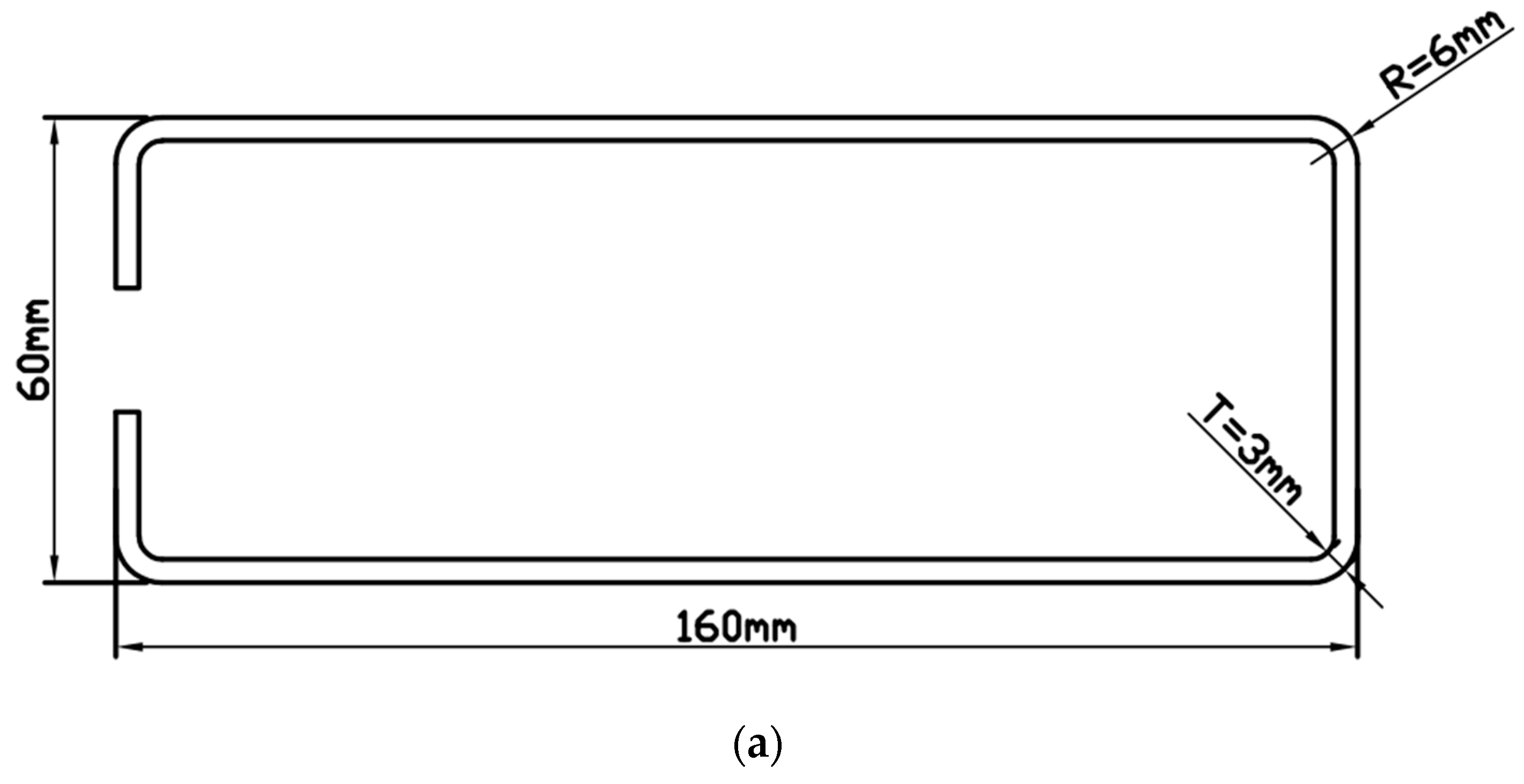


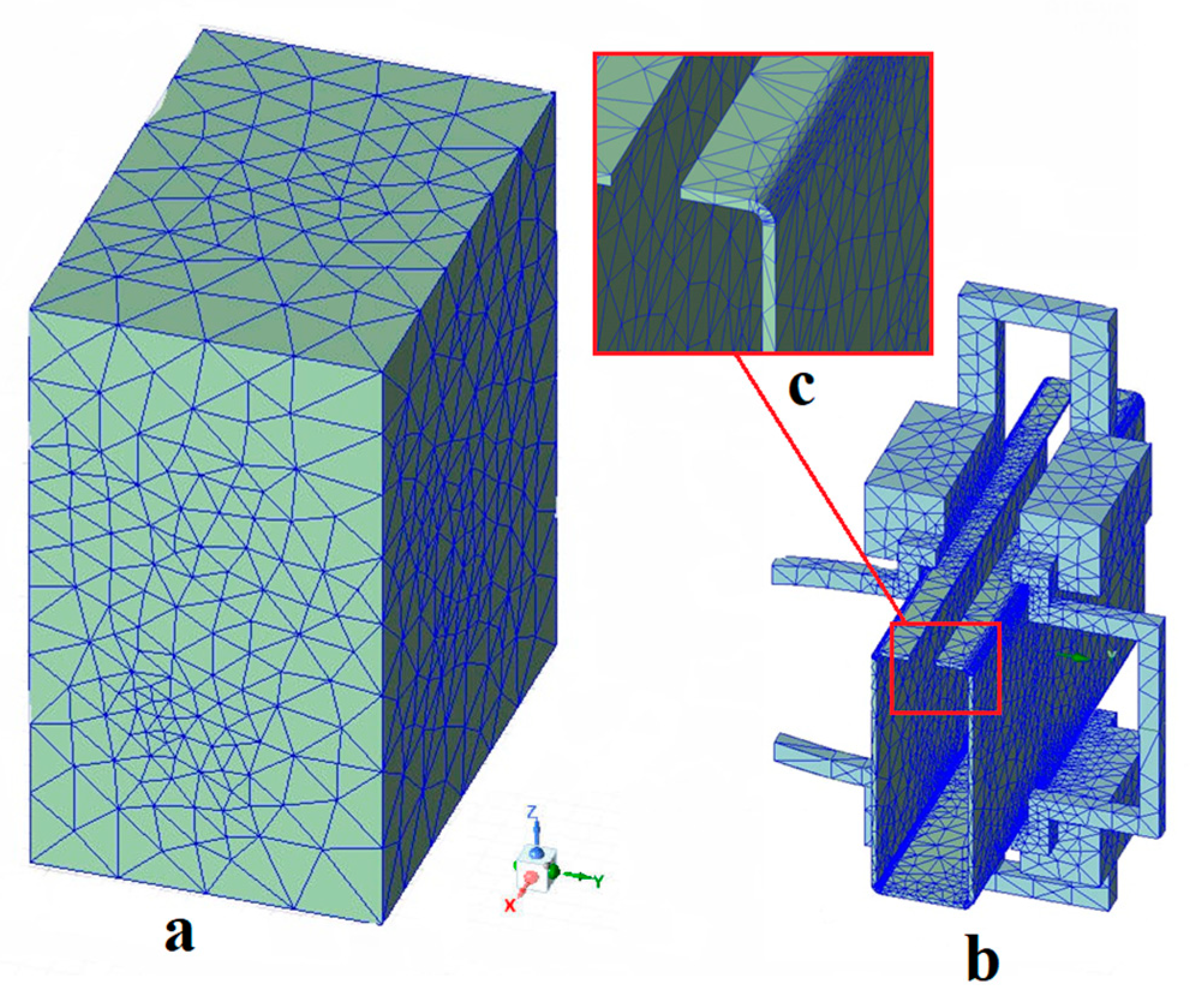
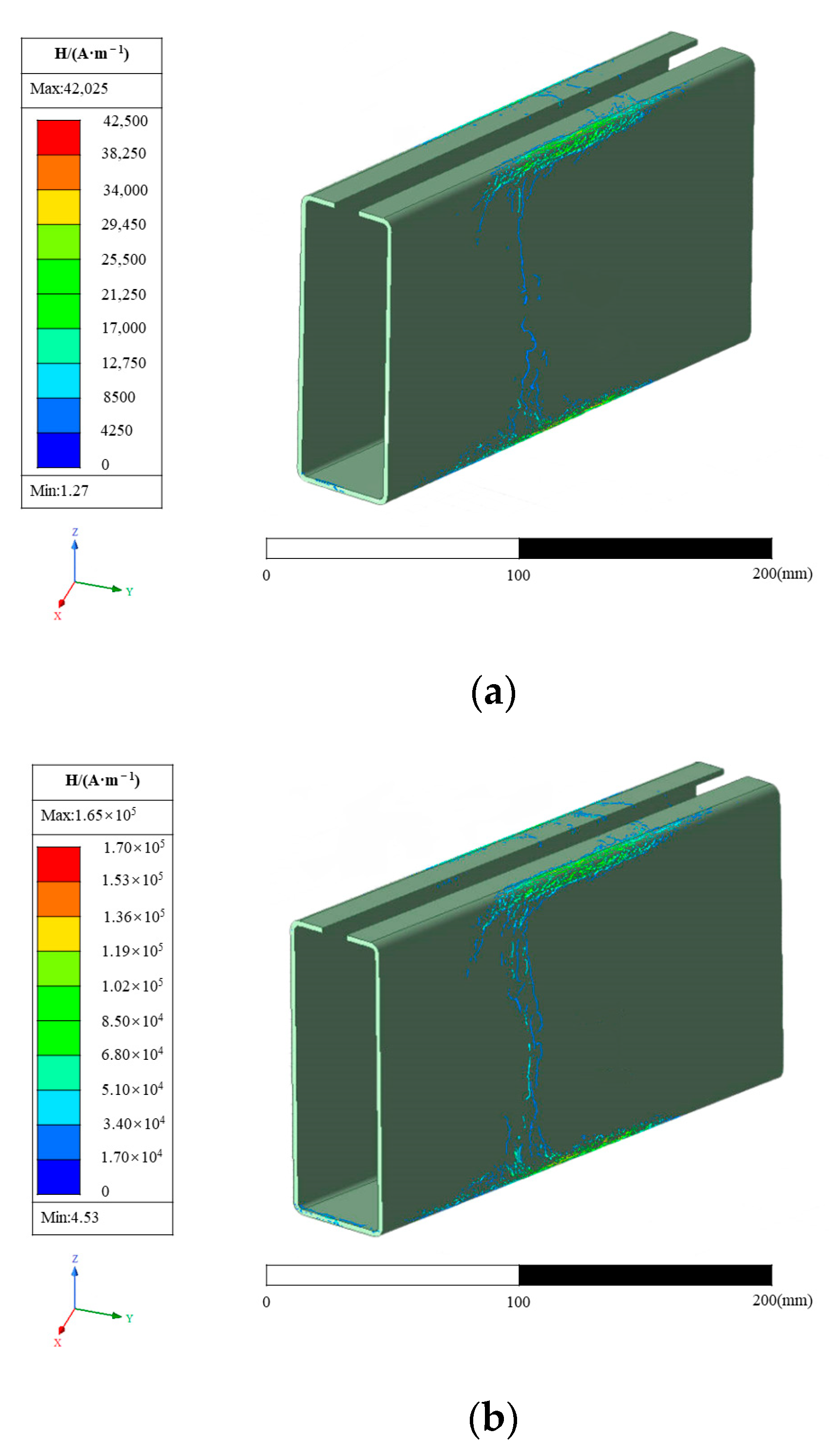
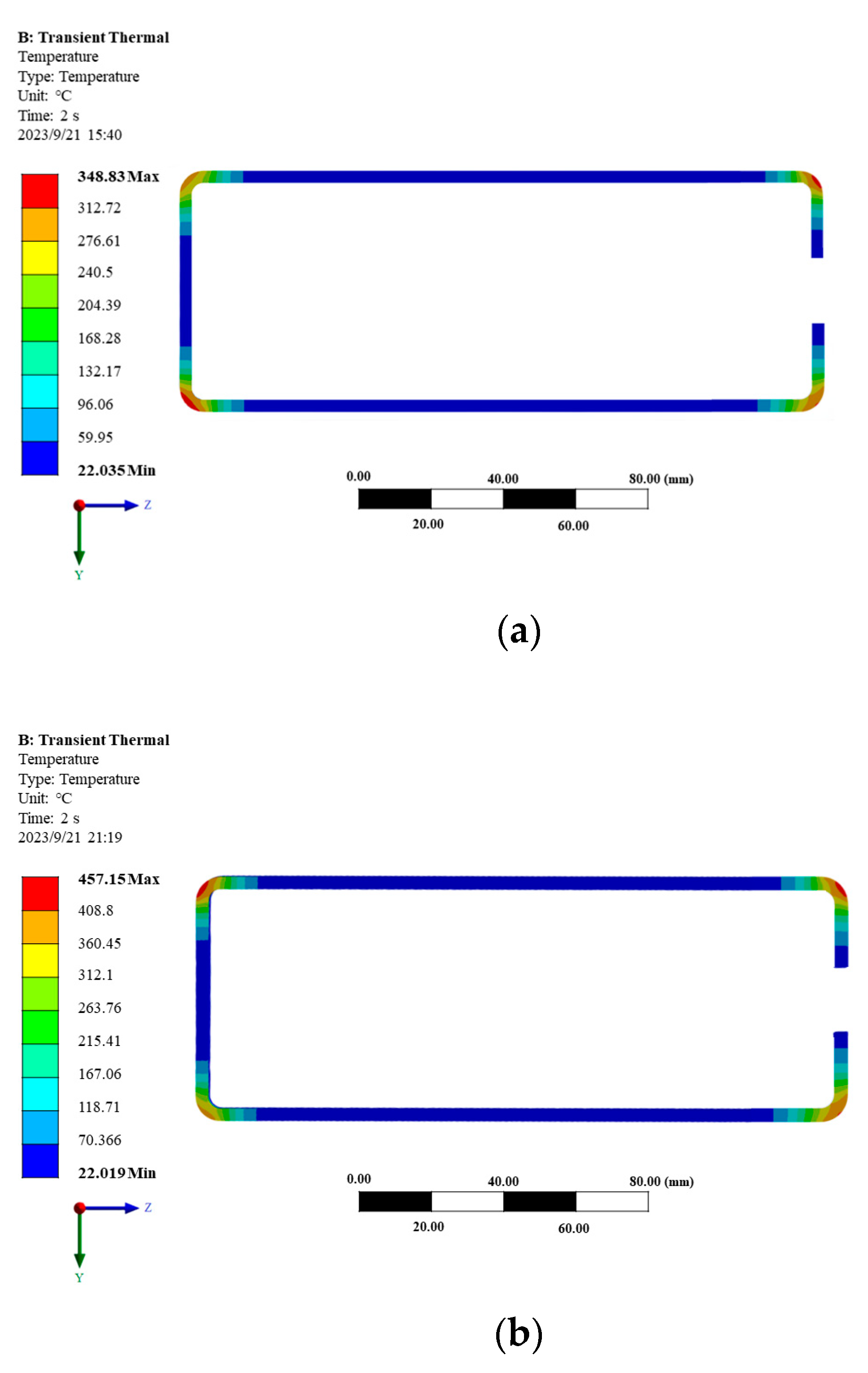
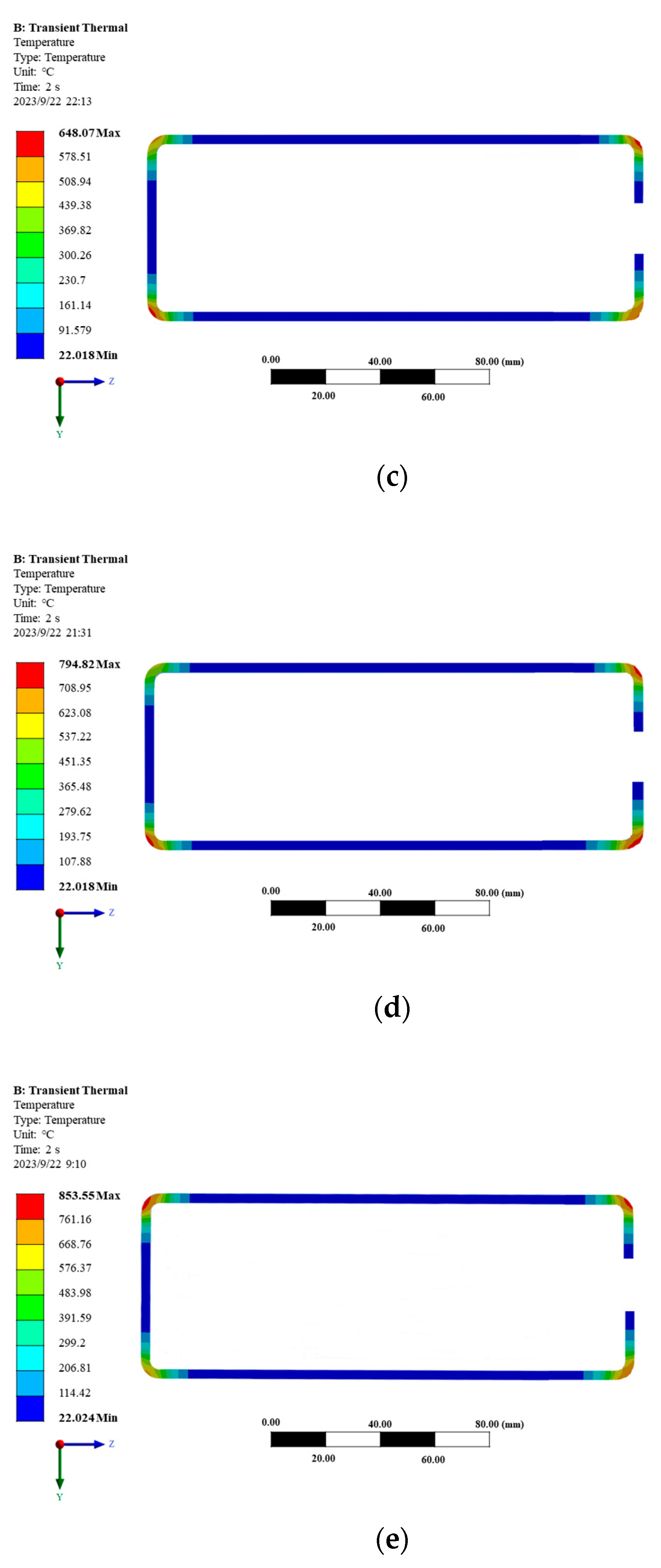
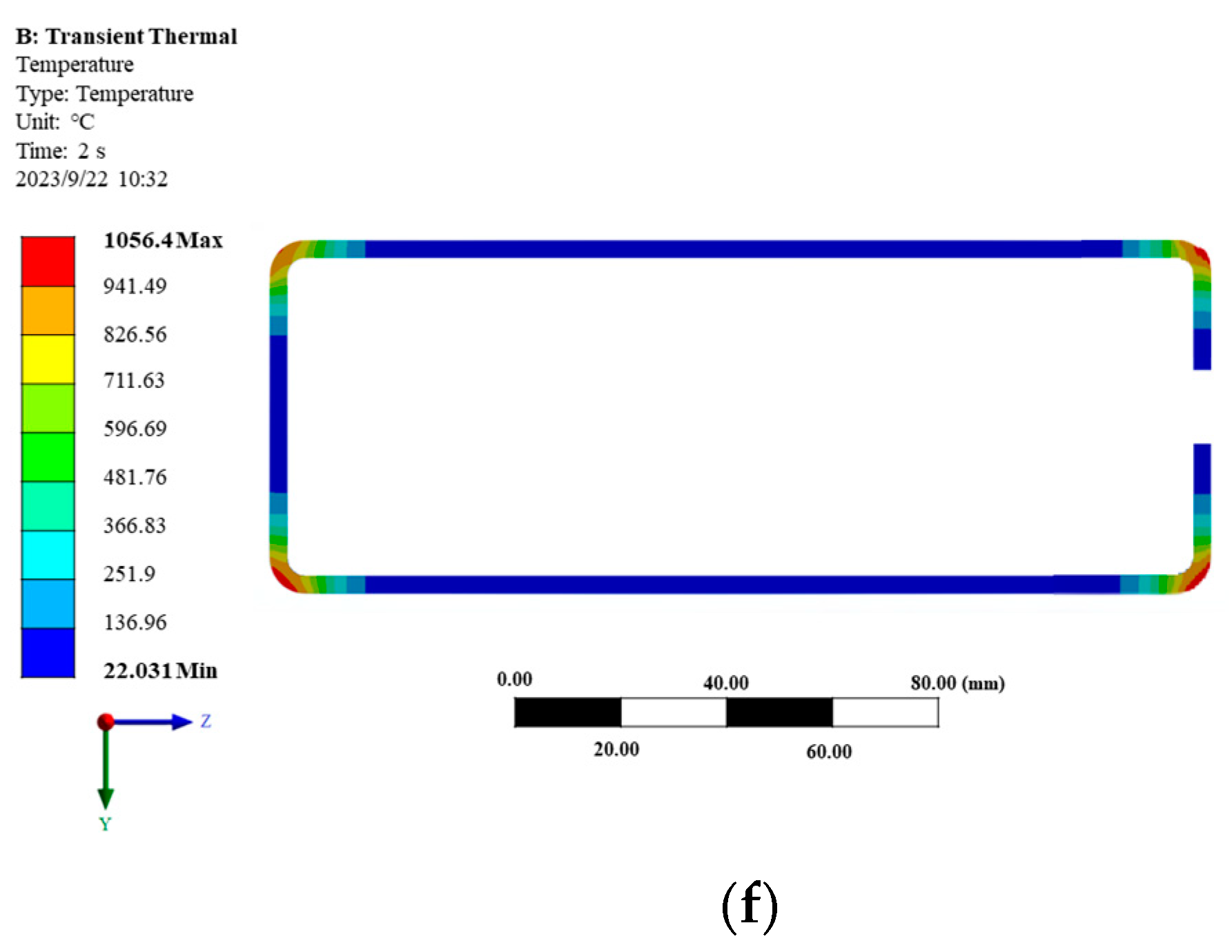

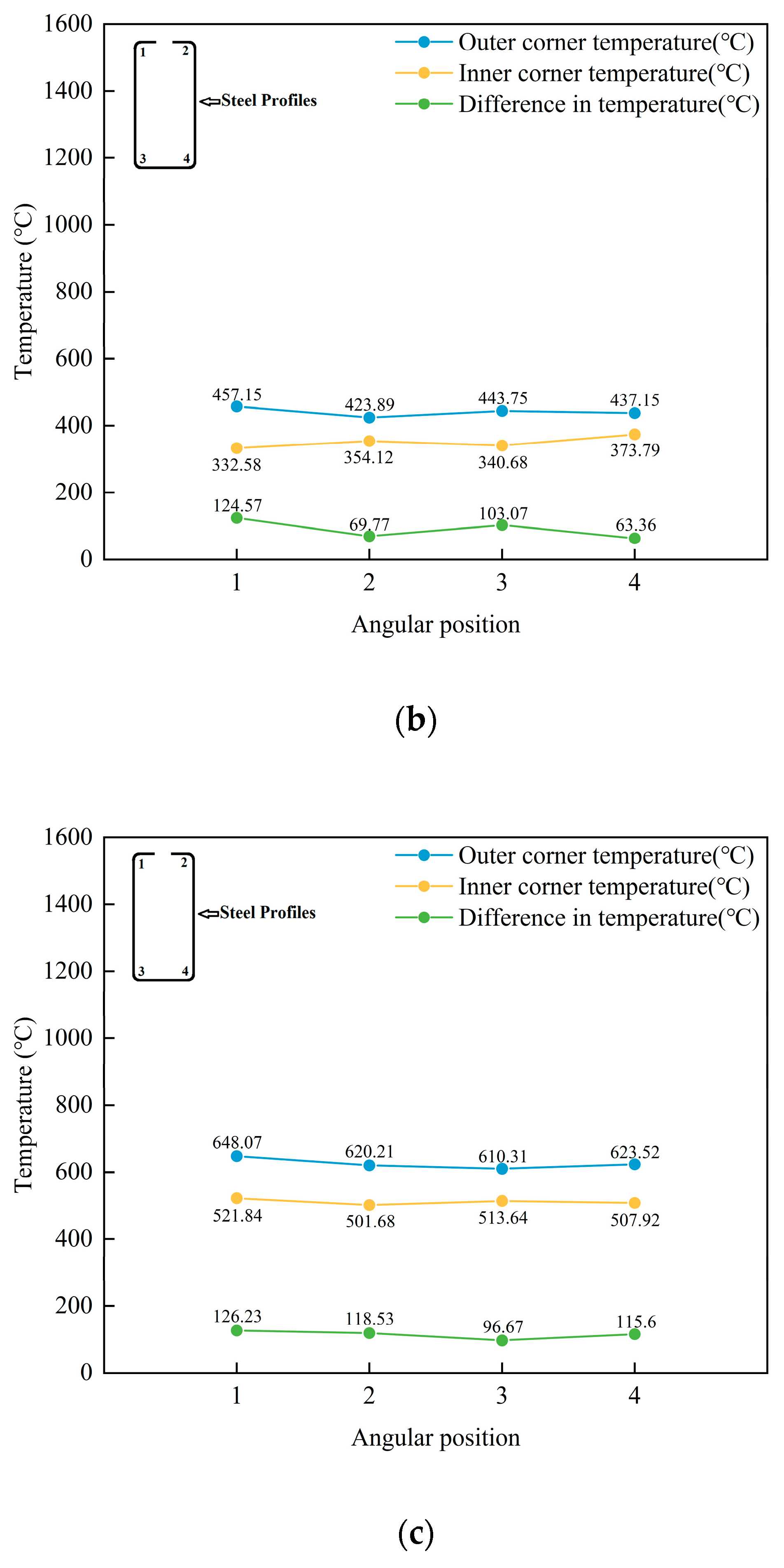
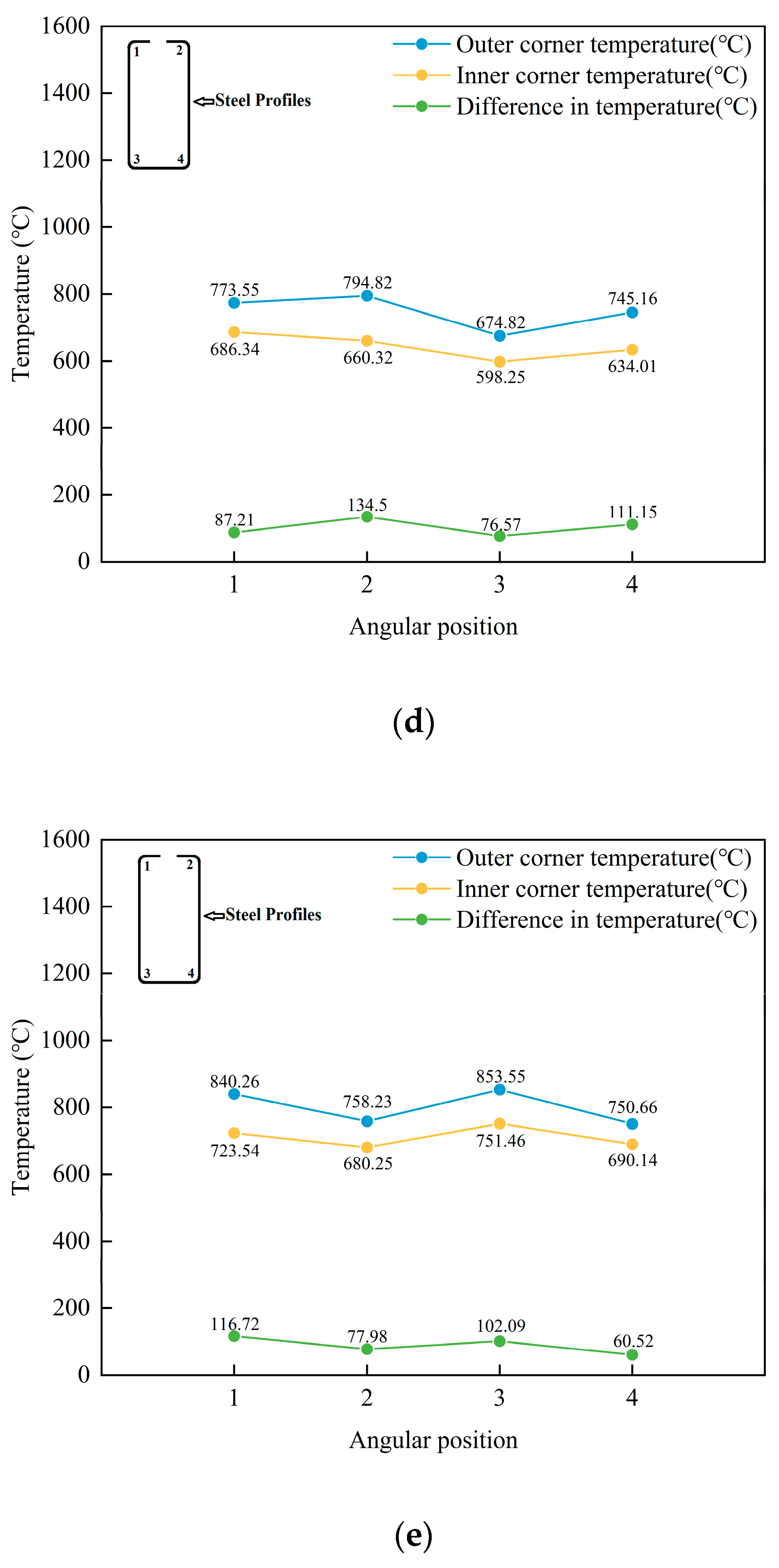
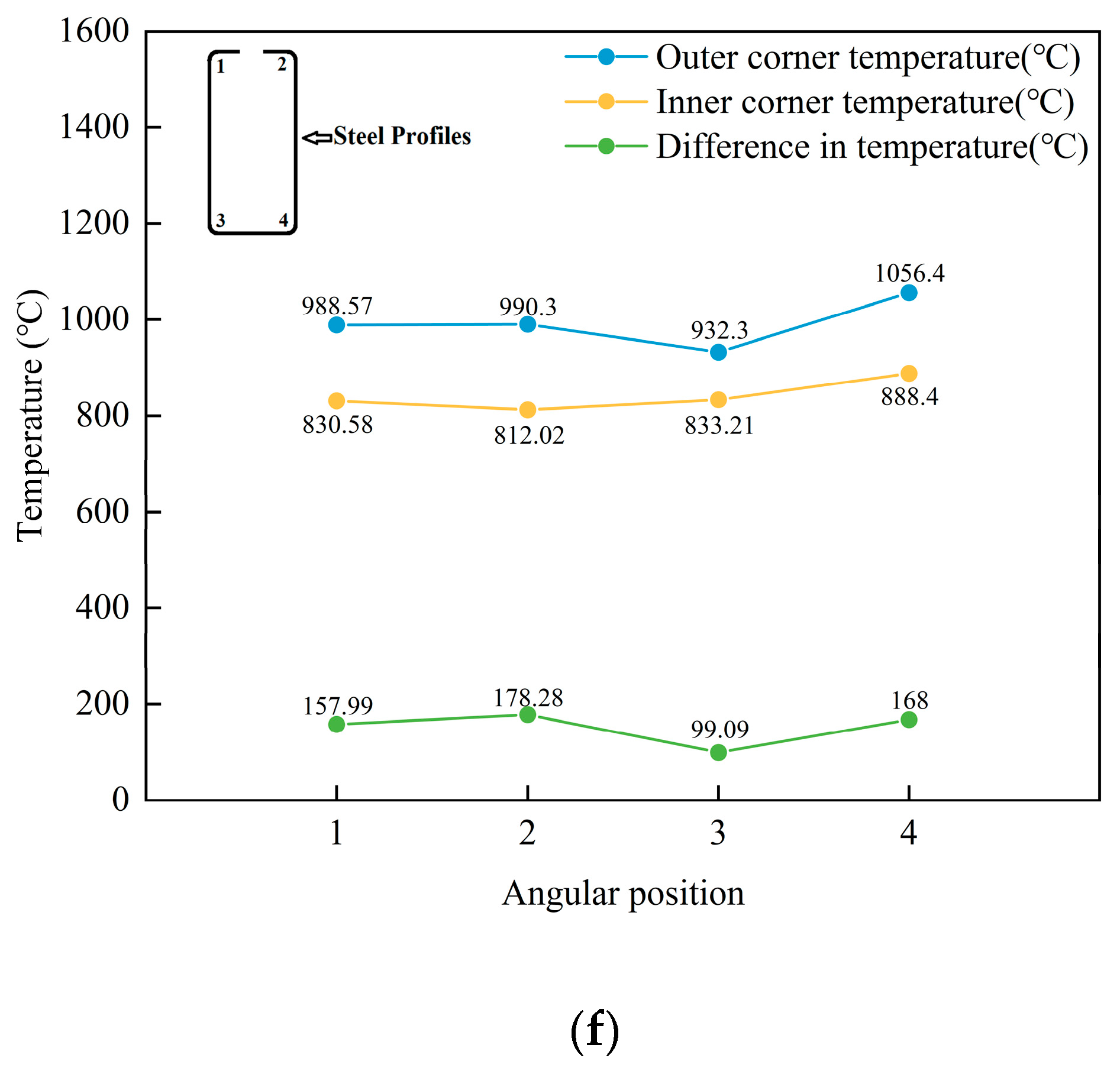



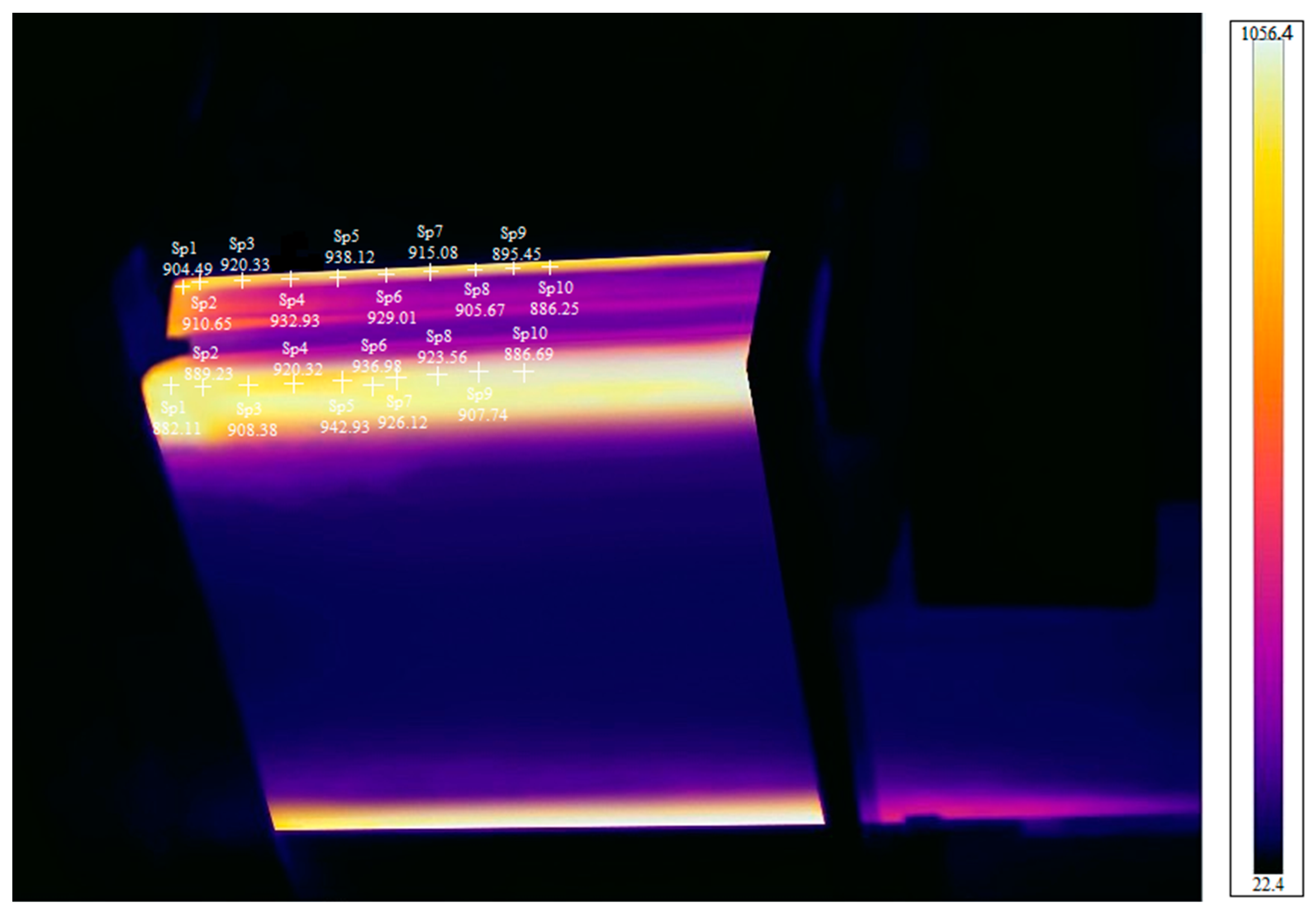
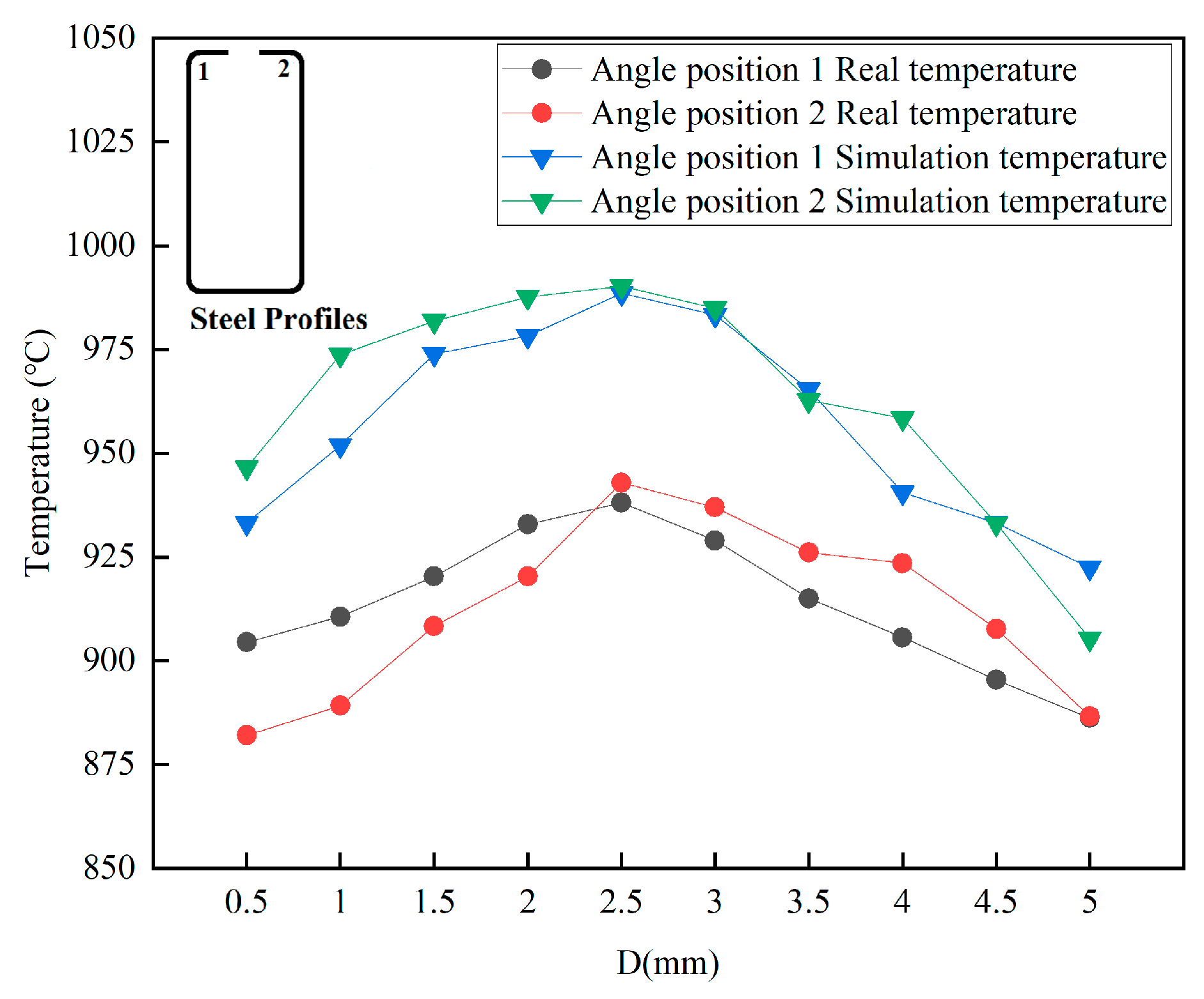
Disclaimer/Publisher’s Note: The statements, opinions and data contained in all publications are solely those of the individual author(s) and contributor(s) and not of MDPI and/or the editor(s). MDPI and/or the editor(s) disclaim responsibility for any injury to people or property resulting from any ideas, methods, instructions or products referred to in the content. |
© 2023 by the authors. Licensee MDPI, Basel, Switzerland. This article is an open access article distributed under the terms and conditions of the Creative Commons Attribution (CC BY) license (https://creativecommons.org/licenses/by/4.0/).
Share and Cite
Yao, W.; Wu, C.; Han, J. Numerical Simulation and Experimental Study of Cold and Hot Composite Forming of Sharp-Edged High-Strength Steel Sections. Materials 2023, 16, 6993. https://doi.org/10.3390/ma16216993
Yao W, Wu C, Han J. Numerical Simulation and Experimental Study of Cold and Hot Composite Forming of Sharp-Edged High-Strength Steel Sections. Materials. 2023; 16(21):6993. https://doi.org/10.3390/ma16216993
Chicago/Turabian StyleYao, Wenqiu, Chunjing Wu, and Jingtao Han. 2023. "Numerical Simulation and Experimental Study of Cold and Hot Composite Forming of Sharp-Edged High-Strength Steel Sections" Materials 16, no. 21: 6993. https://doi.org/10.3390/ma16216993
APA StyleYao, W., Wu, C., & Han, J. (2023). Numerical Simulation and Experimental Study of Cold and Hot Composite Forming of Sharp-Edged High-Strength Steel Sections. Materials, 16(21), 6993. https://doi.org/10.3390/ma16216993





